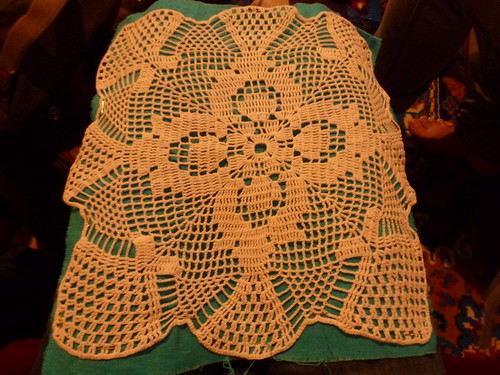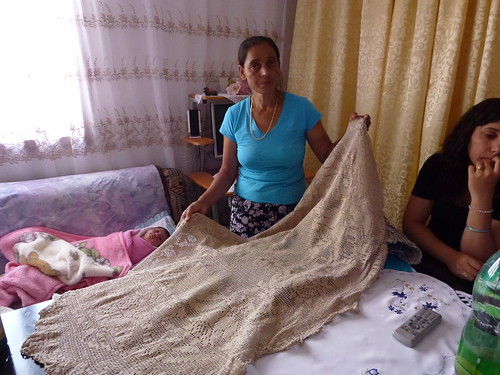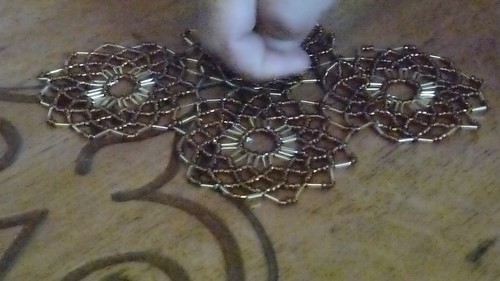In all the Roma houses I’ve visited in the villages around Gracanica, I don’t believe I saw any level surface that wasn’t draped with a handmade piece of embroidery, crocheting or beadwork. Artwork, craftwork is everywhere. But it is difficult to find a Roma woman who classifies herself as an “artist.” For most, their crafts are a part of ordinary life, something they fit in in their spare time to embellish their houses, and sell if they have an opportunity. Creating “high art” is a different story. If making a living as an artist is difficult in the most cosmopolitan cities, it’s next to impossible for Roma in Kosovo’s towns and villages, especially for those who have no resources to get fine arts training, supplies, or transportation to places they can sell their works. In Kosovo, Roma with artistic tendencies seem to keep their talents focused on household decoration.

Gjemilja in Gracanica made this example of tentene, a type of crocheting popular among Roma women and others in Kosovo.
According to Der Spiegel, we’re in the midst of a renaissance in Roma art. I don’t know about the high art world, but from what I can tell, Roma art exists, has existed, has been flourishing as a tradition. This “renaissance” is happening mainly because people outside Roma society have started acknowledging Roma art as more than an ethnographic curiosity. Whether it’s undergoing a rebirth, an awakening or just outside recognition, Farija Mehmeti and her brother Bajram are representing Kosovo in the Roma art movement.
[I should perhaps note now that I am no art critic, so fear not: there will be no talk of simulacra, post-structuralism or semiotics here.]When I first got rolling on this quilt production process, I searched for any Roma, Ashkali or Egyptian women artists who could help with the designs, or at least advise if we ran into trouble turning ideas into pictures. Before the end of my first week in Kosovo, I happened on an online slideshow of bright, vibrant portraits of Roma women. The portraits were sensitive and striking, showing women of different ages, different skin tones, some with flowing hair, others with brightly-colored headscarves, all boldly looking the viewer in the eye. The portraits had recently been exhibited in Kosovo…and had been done by a Kosovar Roma woman artist! She was even, according to the exhibition coverage, the first Roma woman artist to be exhibited in Kosovo. She was exactly who I had been looking for, and I was ready to beg to get her involved with the quilt project. The problem was, I had no way to get in touch with her. Nobody would respond to my messages. Nobody I talked to knew any other Roma artists who would be suitable for the project. I was disappointed, but what to do with the project clock ticking? I didn’t want to bring any more non-RAE voices into the project than necessary (mine was more than enough), so I decided if I couldn’t find an artist of Roma, Ashkali or Egyptian ethnicity, we’d go without to make sure that the images on the quilt would come directly from the communities it was representing.
So we went ahead forming quilting groups, and after a few weeks had passed and the groups were finishing the designs for their squares, I was glad to see that there had been no need to search for any artist other than the talented women who volunteered to work on the project. One of the women in the Gracanica group, however, was especially helpful with the designs – almost everyone else deferred to her to sketch out their squares. Farija worked quietly during our meetings to outline beautiful pictures of Roma women baking bread in traditional outdoor ovens, washing their babies and sweeping their yards.
I was so impressed by these scenes of village life – where did she learn to draw? She told me that she liked to paint, had learned how from her older brother, and that she would like to make a living as an artist. By this point, I’d written off and forgotten about the Roma painter I’d learned about online. It wasn’t until I was invited to her home in the small village of Lapina and saw the watercolor portraits of Roma women hanging on her living room wall that I put it together – soft-voiced, modest Farija was the same woman I’d seen proudly showing her portraits in the online slideshow – of course!
Click on the portrait to see my own slideshow of Farija’s work – portraits and scenes of traditional Roma women’s lives:
I learned Farija has been painting Kosovar Roma women for around ten years, beginning after she watched her brother Bajram discover a love for painting Roma life and developing quite a talent for it. Bajram Mehmeti gained notice partly by his work for Paul Polansky’s books – he provided the illustrations for “Gypsy Taxi.” Between the two of them, they must have hundreds of works stored in the cardboard portfolios they brought out to show me; they devote all the time they can afford to their art.
The pictures are, quite simply, fantastic. These aren’t scenes you usually see of Roma – ones of beggars sitting on the streets or children with dirt-smudged faces sifting through garbage piles to find scraps of food. Brother and sister both depict Roma history and tradition with brightly-colored scenes of idealized villages, people, work and celebrations. Bajram told me, “I want to show Roma life as it really is, as well as express myself.” These are a couple of Bajram’s pastoral scenes:
For Farija, it’s important to show Roma women as they are today and as they lived in the past. Farija has said she is “inspired by women’s strength because they carry the burdens of the past, present and future.” Her designs for the quilt draw on that same inspiration.
Farija is interested in traditional life, showing the beautiful dress and quiet life that used to be common to Roma women. The portraits of village life honor Roma women with their vibrancy. They show the strength of women devoting their days to work and caring for their families – washing, cooking, cleaning, serving guests, caring for children. They show how Roma women try to beautify the mundane – how Roma houses are kept very clean and (like many Roma women themselves) are covered with decoration – flowers, bright colors. They venerate tradition even as they points out the hardship of everyday Roma life.
While the designs are beautifully done, they clearly depict the poverty in which many Roma are living as well. Farija wanted to show how poverty continues to make the lives of Roma women difficult. She points out that small things, like having to wash all the family’s clothes by hand, help keep Roma women tied to the domestic sphere. The amount of housework they have to do provides an argument for why there is no need for them to be educated or to seek outside employment – they have plenty of work to complete inside the home. Farija hopes her designs will encourage those outside her community to think about the way in which Roma are living, and how they can help improve these lives. Her designs suggest that small improvements (like getting washing machines) could have a big impact on daily life. She especially wants this message to travel outside Kosovo. Her ultimate goal is to help raise the position of Roma women in Kosovo.
Like her portraits, the quilt squares suggest that the interaction between tradition and modern life is not always easy. Is the traditional way of life bound up with poverty? Farija’s pictures in particular bring up a question that “Jemail” raised in one of the Paul Polansky poems I included in my last post – What aspects of Roma culture and tradition make Roma people distinctly Roma? How can these traditions be protected and honored, and should they all be? How to reconcile traditions that are at odds with modern life in the majority society?
Farija herself has had to negotiate between tradition and modern ideas, especially ideas of women’s rights. She loves the beauty of Roma tradition, but she rejects tradition when it costs Roma women their freedom. Farija made a stand, refusing several attempts by her parents to arrange a marriage for her. She maintained that she would only marry a man who respected her, whom she loved. Eventually, she said, her parents stopped trying to force her into marriage. Her younger sister took up the same tactic and was able to resist marriage at a young age.
Still living in a community bound by the tradition of young marriage, Farija’s decision has had consequences for her. At 32, she lives at home with her parents, brother and sisters. Due to the mentality prevalent in the village, it’s likely that because of her age, only widowers and divorcés would consider marrying her; she would need to find a fellow iconoclast if she wanted to be with someone who would respect her views on marriage. But she seems to be happy with her choice to keep her freedom and follow her own path as an artist. She dreams of becoming a clothing designer; although in our conversations there was always the unspoken acknowledgment that affording to achieve this dream will be very difficult.
George Soros (whose Open Society Institute initiated the Roma Pavilion at the Venice Biennale) and others have made a point of featuring Roma artists to gather attention and momentum for Roma empowerment. They hope to convince the rest of us that the Roma deserve better than the discrimination and persecution that has historically been Europe’s comment on Roma existence. But what about Roma art and craft that doesn’t fit the conventions of contemporary art? It’s worthwhile to look at the artwork of those who haven’t been trained or make their living off gallery shows (at least not yet) – and I think the Kosovo quilts will say this loud and clear. And hopefully, seeing Farija’s designs will encourage more people to support her talent.
Farija has shown her work in Pristina and Gracanica; Bajram has exhibited in Kosovo as well as in Switzerland and Austria. It’s not easy to gain exposure to their work when they are a couple borders and cultures away from the mainstream European art scene, but it seems that little by little outsiders are starting to take notice. As I was finishing my visit, an artist from Pristina drove up unannounced to meet with Bajram about the possibility of exhibiting; a couple artists from Italy have also taken interest in supporting the siblings. I don’t know what the result will be, but I hope to hear about an exhibition of Farija and Bajram’s work in the Biennale before too long.
Posted By Samantha Hammer
Posted Aug 4th, 2011








